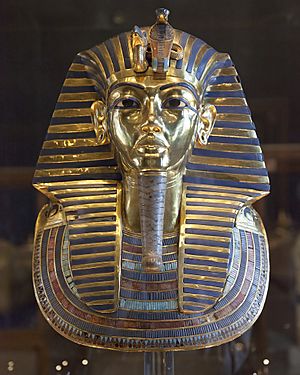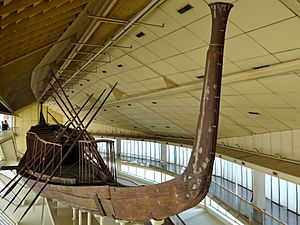Grand Egyptian Museum facts for kids
 |
|
|
Entrances to the Grand Egyptian Museum
|
|
| Established | 2002. |
|---|---|
| Location | Cairo–Alexandria desert road, Giza, Greater Cairo, Egypt, near the Giza Pyramids |
| Type | Archaeology museum History museum |
| Collection size | More than 100,000 |
| Visitors | 4,000 daily (trial period) (2024) |
| Public transit access | Cairo Metro Line 4, Pyramids Station (under construction) List of Cairo Metro stations |
The Grand Egyptian Museum (GEM) is a huge and exciting museum in Giza, Egypt. It is the largest museum in the world dedicated to a single ancient civilization. You can find it about two kilometers (1.2 miles) from the famous Giza Pyramids.
This amazing museum was first planned in 1992. Construction started in 2005 and finished in 2023. It cost about $1.2 billion to build. A trial opening for visitors began in October 2024. The museum officially opened its doors on November 1, 2025.
The GEM holds a massive collection of ancient Egyptian treasures. These artifacts come from different times in Egyptian history, from the very earliest periods to Coptic Egypt. There are over 100,000 items in total. About 20,000 of these are being shown for the first time ever.
One of the most special parts of the museum is the complete collection of King Tutankhamun. This collection has 5,398 pieces and is displayed in a huge 7,500 square meter area. Other newly restored items are also on display. These include the second solar ship of Khufu and collections from Queen Hetepheres and Yuya and Thuyu.
The museum covers a total area of 500,000 square meters (about 5.4 million square feet). It has permanent galleries, special exhibitions, and even a children's museum. There are also virtual screens to help visitors learn more.
Contents
- Discovering Ancient Egypt: The Grand Egyptian Museum's Story
- Exploring the Museum's Amazing Collections
- The Grand Hall: A Royal Welcome
- The Grand Staircase: A Journey Through Time
- The Conference Center: A Place for Learning
- The 12 Main Halls: A Timeline of Egypt
- The Children's Museum: Fun for Young Explorers
- Tutankhamun Halls: The Boy King's Treasures
- Khufu Ships Museum: Ancient Boats
- Temporary Exhibition Halls: Changing Displays
- The Conservation Center: Protecting History
- Designing the Grand Egyptian Museum
- How the Museum is Managed
- Special Events at the Museum
- See also
Discovering Ancient Egypt: The Grand Egyptian Museum's Story
The idea for the Grand Egyptian Museum began in the early 1990s. Farouk Hosny, who was Egypt's Minister of Culture, wanted a new museum. He felt the old Egyptian Museum in Tahrir Square needed an update.
The government officially started the project in 1992. President Hosni Mubarak announced plans for a new museum. It would hold more artifacts and bring ancient treasures together. The first stone for the museum was laid in 2002. Actual building work began in 2005.
The Grand Opening Journey
The opening of the Grand Egyptian Museum was planned several times. It faced delays due to different reasons. These included the COVID-19 pandemic and the need to finish construction. There were also challenges in moving all the ancient artifacts safely.
A trial period for visitors started in October 2024. During this time, the museum welcomed about 4,000 visitors each day. The museum officially opened its doors to the public on November 1, 2025.
Celebrating the Grand Opening
The Grand Egyptian Museum officially opened on November 1, 2025. Many important people attended the opening ceremony. These included Egyptian President Abdel Fattah el-Sisi and the First Lady. Kings, queens, and prime ministers from other countries were also there.
The ceremony featured speeches from famous figures like Professor Sir Magdi Yacoub and Farouk Hosny. Music for the event was composed by Hesham Nazih. Egyptian artists like Sherihan, Fatma Said, and Yasmina El-Abd also took part. Actors and Olympic athletes helped tell the story of ancient Egyptian kings and queens.
Exploring the Museum's Amazing Collections
The museum has more than 100,000 artifacts. These are spread across 12 main permanent exhibition halls. There are also several other special areas to explore.
The Grand Hall: A Royal Welcome
The Grand Hall, also called the Atrium, is the museum's main entrance. It is a massive space, covering 10,000 square meters. It has a glass roof and clear walls. From inside, you can see the Giza Pyramids!
This hall features the giant statue of Pharaoh Ramesses II. It stands 11 meters tall and weighs 83 tons. About 20 to 30 other large artifacts are also displayed here. They give visitors a first look at Egypt's ancient history. The statue was moved to the GEM in 2006 and placed in the Grand Hall in 2018.
The Grand Staircase: A Journey Through Time
The Grand Staircase is more than just stairs. It's a special gallery with over 60 artifacts. It leads visitors up to the 12 main exhibition halls. This impressive structure is six stories tall, about 50 meters high. It connects different parts of the museum. From the upper terrace, you can get another great view of the Giza Pyramids.
The artifacts on the staircase are arranged into four themes. These themes show how pharaohs were seen and how they related to the gods. You can see royal statues, religious artwork, and stone coffins.
The Conference Center: A Place for Learning

The museum also has a large Conference Center. It is designed to host meetings, workshops, and educational events. These events focus on ancient Egyptian civilization and archaeology.
The center has a main auditorium with 1,000 seats. There are also smaller halls and a 3D theater. Its design is inspired by ancient Egyptian sites.
The 12 Main Halls: A Timeline of Egypt
These halls display over 24,000 artifacts. They are organized by different time periods of ancient Egyptian history. The items come from many places across Egypt.
| 12 main halls | The time periods covered by each hall of ancient Egyptian history |
|---|---|
| Halls (1-2-3) | The earliest eras, including the Pre-dynastic, Early Dynastic, and Old Kingdom periods. |
| Halls (7-8-9) | The exciting era of the New Kingdom. |
| Halls (4-5-6) | The Middle Kingdom and the Second Transition period. |
| Halls (10-11-12) | The Third Transition, Late Period, and the Roman and Greek times in Egypt. |
The Children's Museum: Fun for Young Explorers
The Children's Museum is a special place for kids aged 6 to 12. It focuses on learning through play. It has interactive screens, Augmented reality (AR) games, and hands-on activities. This area has been partly open since August 2024.
Tutankhamun Halls: The Boy King's Treasures

Two of the museum's halls are completely dedicated to King Tutankhamun. He was a pharaoh from the Eighteenth Dynasty. These halls display all 5,398 items from his tomb. This is the first time his entire collection has been shown in one place. Before, only some pieces were at the old Egyptian Museum.
These halls are designed to feel like Tutankhamun's original tomb. Special systems control the temperature and humidity. This protects delicate items made of gold, wood, and fabric.
The most famous item is the golden Mask of Tutankhamun. It is one of the world's most recognized artifacts. You can also see three coffins, one made of 110 kg of pure gold. The Golden Throne, covered in gold and silver, shows scenes of Tutankhamun and his wife. There are also statues of gods, jewelry, weapons, furniture, and small statues called ushabti. These ushabti were believed to serve the king in the afterlife.
King Tutankhamun's mummy will stay in its original tomb in the Valley of the Kings. It was not moved to the museum.
Khufu Ships Museum: Ancient Boats

This separate hall is dedicated to the two solar boats of King Khufu. He was the pharaoh who built the Great Pyramid. These boats are some of the oldest wooden ships ever found, about 4,600 years old! An interactive display helps explain what these boats might have been used for. Perhaps they carried the king to the afterlife or helped him travel with the sun god Ra. One of the ships was moved here in August 2021.
Temporary Exhibition Halls: Changing Displays
The museum has four halls for temporary exhibitions. These halls show different artifacts or special international displays. They cover a large area and offer new things to see regularly.
The Conservation Center: Protecting History
The Grand Egyptian Museum has one of the largest centers for restoring ancient artifacts in the world. It's like a special hospital for old treasures. This center opened in 2010. It has 19 laboratories to fix mummies, wood, stones, paintings, and metals. There are also special rooms to keep artifacts safe in the right environment.
Designing the Grand Egyptian Museum
The design for the museum was chosen through a big competition in 2002. Architects from all over the world submitted their ideas. The winning design came from Róisín Heneghan and Shi-Fu Peng from Ireland.
The building has a unique triangle shape. It sits about 2 kilometers (1.2 miles) northwest of the pyramids. The museum's walls line up perfectly with the Great Pyramid of Khufu and the Pyramid of Menkaure. The front of the museum has a large open area with palm trees. Its outer walls are made of shiny alabaster stone.
The museum's walls are made of marble and glass. They are decorated with ancient Egyptian hieroglyphs. These carvings show the names of kings and queens.
The Museum's Logo
The museum's special logo was revealed on June 10, 2018. It was designed by Tariq Atrissi.
How the Museum is Managed
The Grand Egyptian Museum is run by a team of people. This includes a Board of Trustees and a Board of Directors. These groups help make sure the museum follows its plans and policies.
Special Events at the Museum
Since its trial opening, the museum has hosted various cultural events. On January 20, 2023, the first musical concert was held there. It featured Egyptian soprano Fatma Said and the United Philharmonic Orchestra & Choir.
See also
 In Spanish: Gran Museo Egipcio para niños
In Spanish: Gran Museo Egipcio para niños
- Egyptian Museum
- List of museums of Egyptian antiquities




















